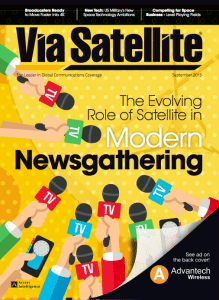Latest News
 [Via Satellite 08-26-2015] If Moore’s law continues to be an indicator of the pace of technology, then the flurry of activity seen throughout the satellite industry might be the new norm. In the September issue of Via Satellite Magazine, we talked with experts across the industry on how the evolution of satellite technology is influencing their work. Looking at video trends, we spoke to cutting edge broadcasters about their 4K plans, and to top news companies around the world about how they choose communications equipment for breaking stories. On a different kind of frontline, we also spoke to military technology leaders in the U.S. about hosted payloads, SmallSats and the potential for LEO-based satellite communications.
[Via Satellite 08-26-2015] If Moore’s law continues to be an indicator of the pace of technology, then the flurry of activity seen throughout the satellite industry might be the new norm. In the September issue of Via Satellite Magazine, we talked with experts across the industry on how the evolution of satellite technology is influencing their work. Looking at video trends, we spoke to cutting edge broadcasters about their 4K plans, and to top news companies around the world about how they choose communications equipment for breaking stories. On a different kind of frontline, we also spoke to military technology leaders in the U.S. about hosted payloads, SmallSats and the potential for LEO-based satellite communications.
These feature stories and several more are delivered in our new seamless digital format. To preview this issue, we present to you the top 10 quotes from Via Satellite September:
“I see a change of use for satellite. I think just providing a video uplink is no longer acceptable. You can’t tweet across that; you can’t email across that, blog or vlog across that. These are all things that news teams need to be able to do these days, and delivering IP connectivity allows you to do all of them.” — Richard Pattison, deputy head of technology at Sky News
“With a satellite the size of a loaf of bread we were able to communicate between Colorado Springs and Huntsville, Ala.” — John London III, chief engineer, U.S. Army SMDC Space and Strategic Systems Directorate
“The industry is gradually realizing that in order to speed up the uptake of 4K, it will require large investments in top-notch broadcast equipment. We need to produce real 4K content; not just upscale as seen in the early days of HD.” — Michael Sichler, CEO, pearl.tv
“I know there are people out there who want to kill me.” — Jenan Moussa, journalist, Al Aan TV
“When CNN deploys to cover the news, quick decisions need to be made as to what equipment and how much suits the story to meet the coverage needs.” — Frank Barnett, VP CNN Satellites and Transmissions
“I’ve learned more than I ever thought. There’s so much that can be gained by spending time working day in and day out with people who have been at the company or in the industry for 20 years or more.” — Steven Fisher, flight dynamics engineer, Intelsat
“With competition amongst our vendor pool for hosted payload solutions, we’re seeing creative opportunities from our contractor pool and feel strongly that once we’ve demonstrated a successful mission through the HoPS contract, we’ll see much more interest.” — Lt. Gen. Sam Greaves, commander at SMC, and program executive officer for space
“In my view, one cannot compare 4K and 3-D, with the latter being limited to just a few topics and areas that are attractive for viewers. Ultra-HD is a better quality in focus achieved through just a general change of camera positions and processes during HD production. One possibly has to invest more in lighting design than ever before in order to achieve optimal results; however, extensive use of 4K offers many new opportunities and new standards in live production sets.” — Frank Meissner, chief broadcast technology and production officer, WeltN24
“If we could get through triple-canopy jungle coverage with a [Ultra High Frequency] UHF signal, that would be very significant, and we think we have that opportunity with a very small satellite in LEO because you get such an enhanced effect since you are so much closer.” — John London III, chief engineer, U.S. Army SMDC Space and Strategic Systems Directorate
“In my experience, shooting in 4K is not much more expensive than in HD. Keeping on the technological pulse is in the broadcaster’s DNA. … We’re also looking at High Dynamic Range (HDR) to see how this can be incorporated into our 4K delivery.” — Jaime Hindhaugh, chief operating officer, BT Sport and BT TV
Get the latest Via Satellite news!
Subscribe Now